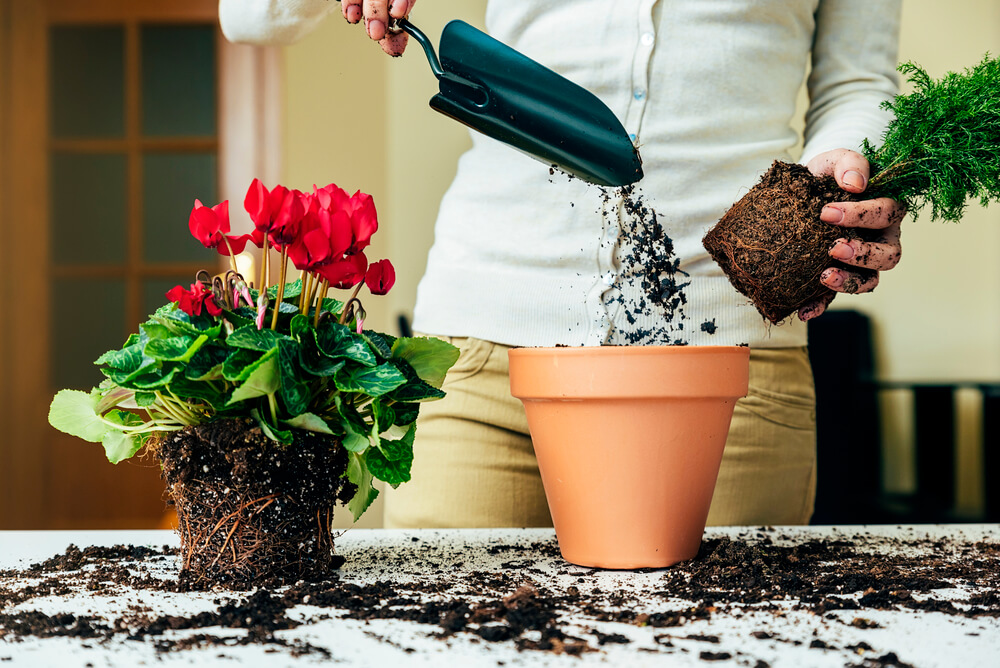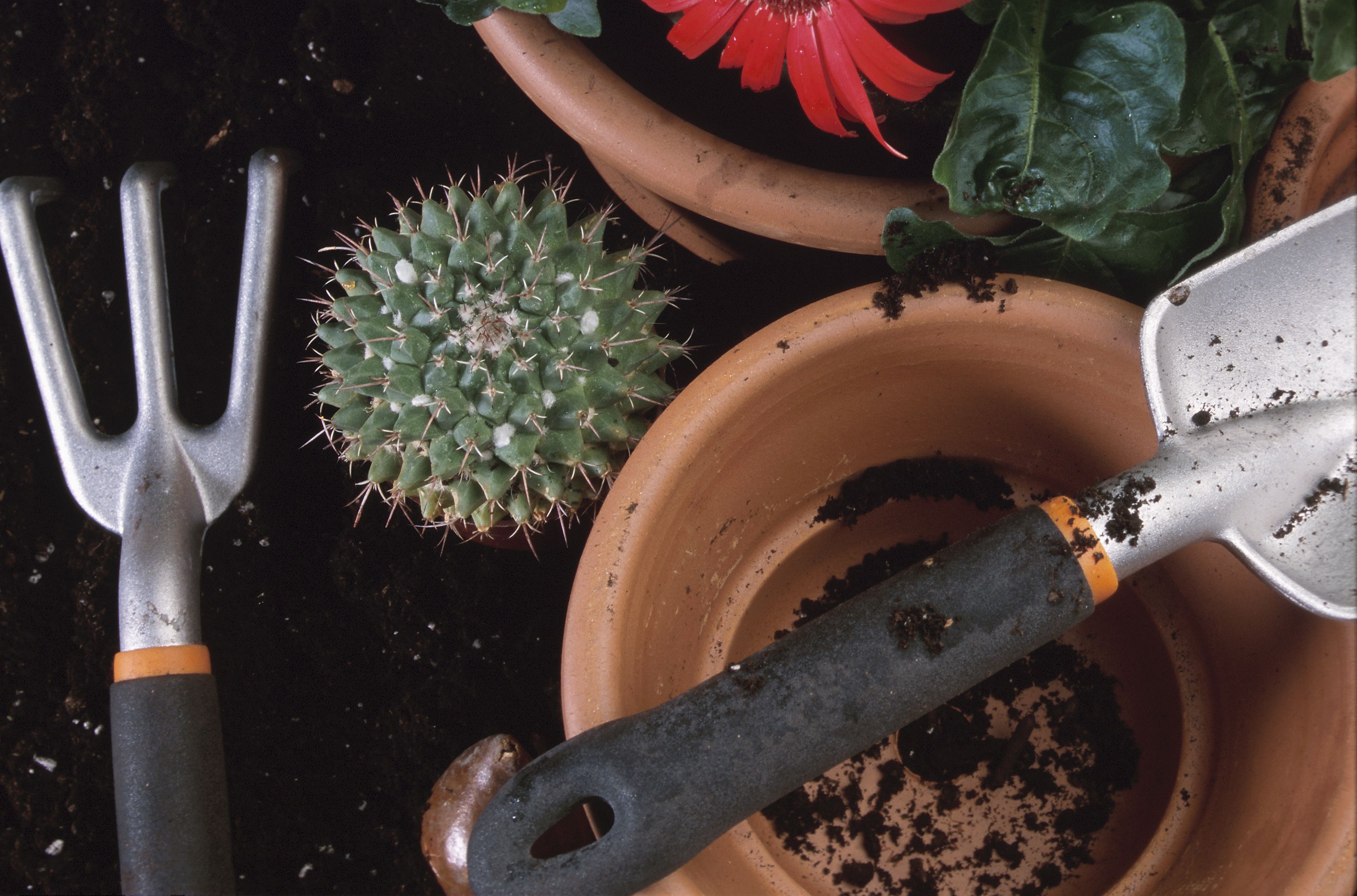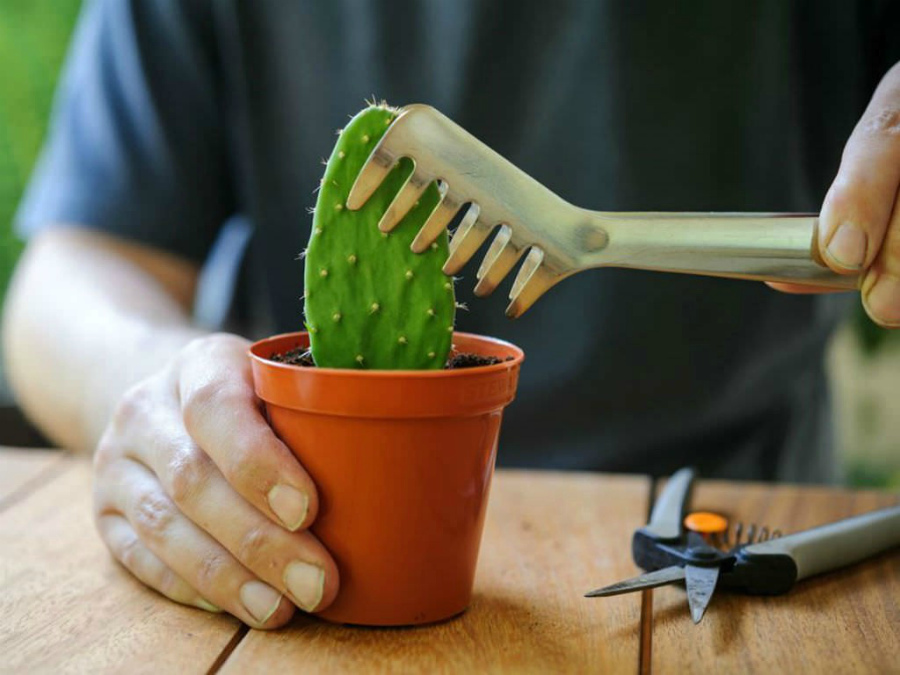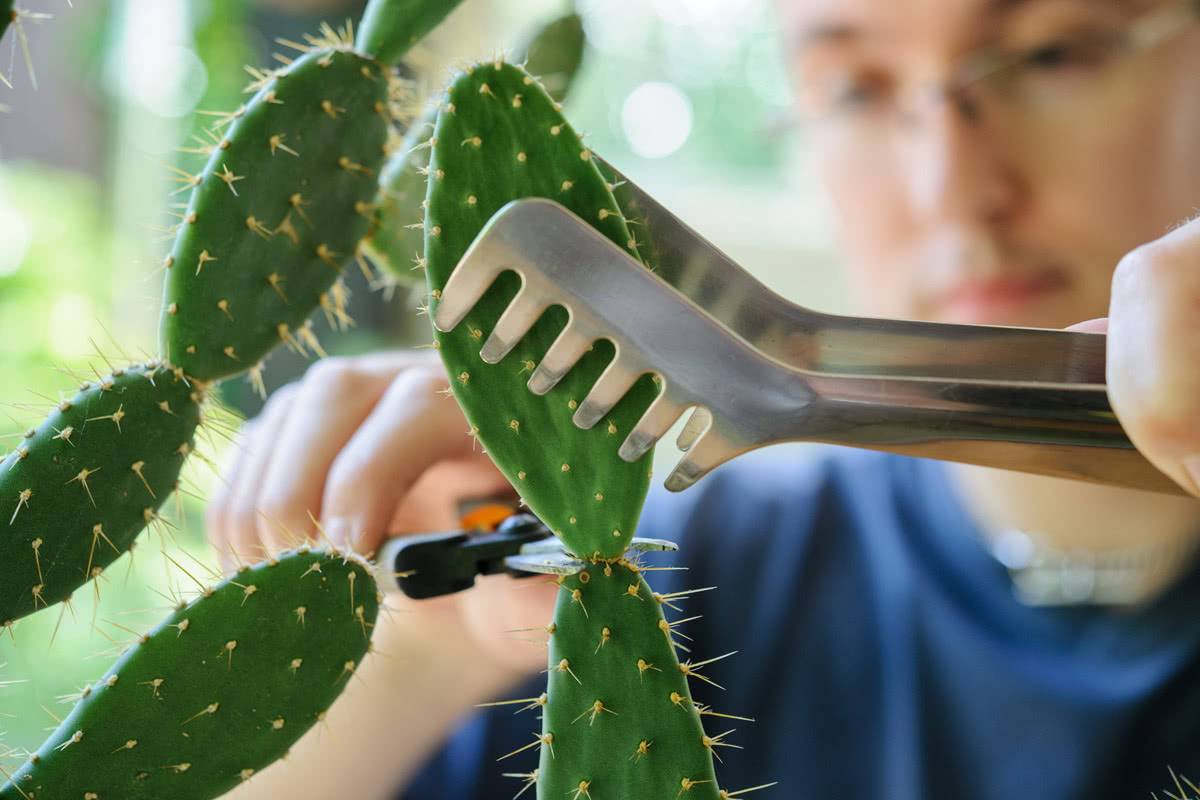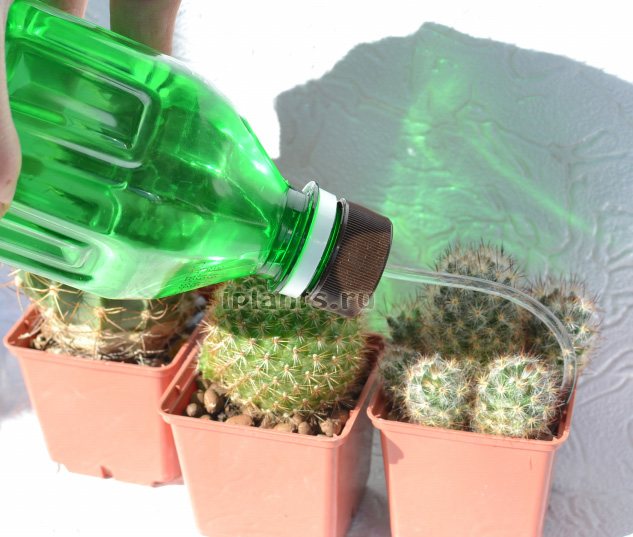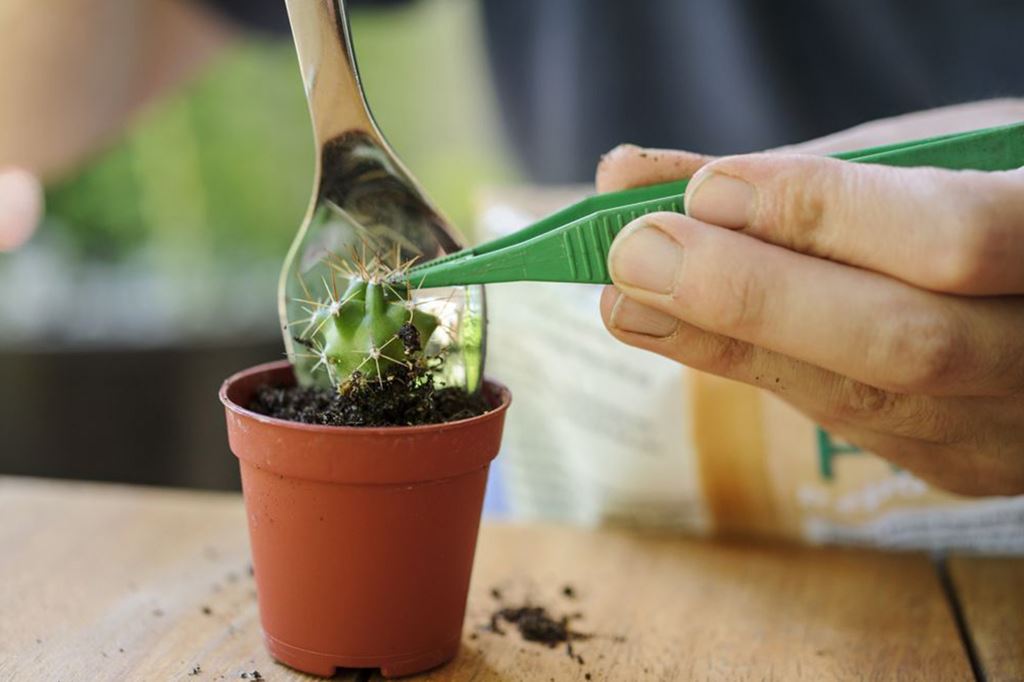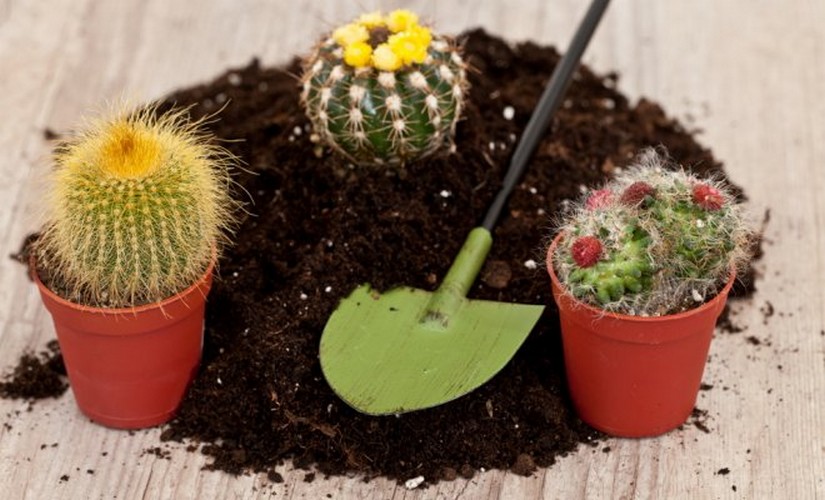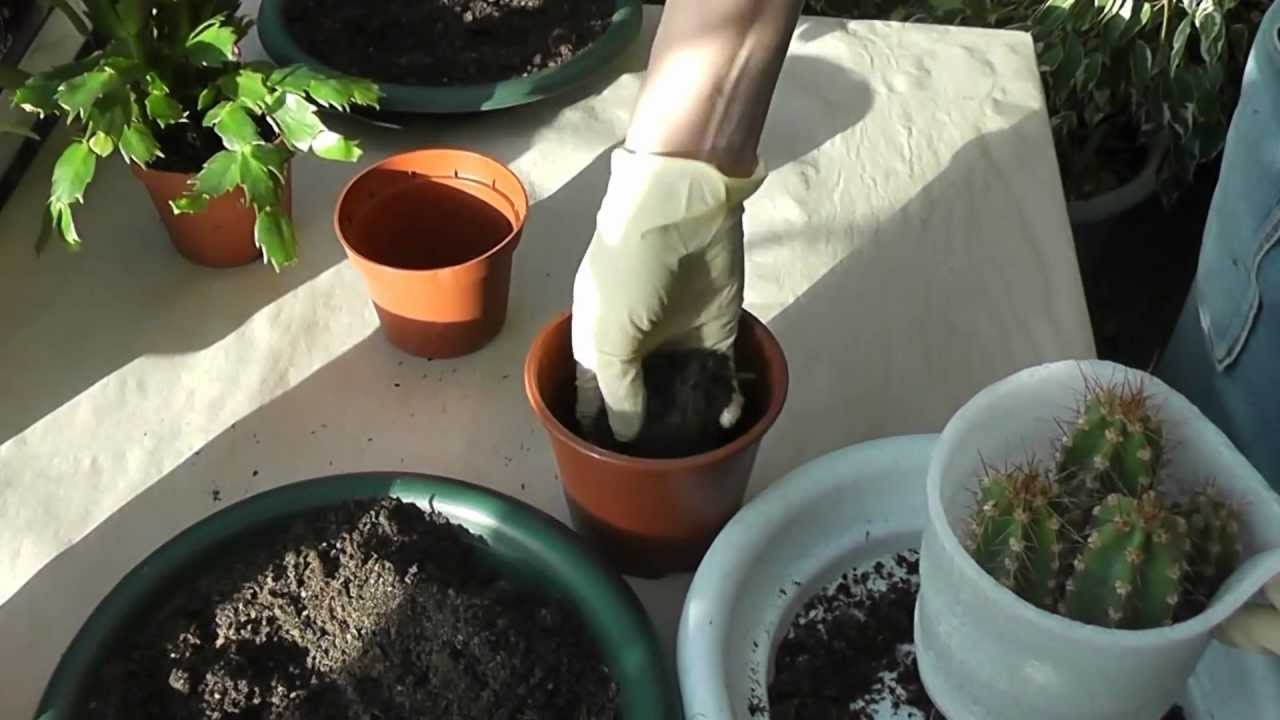How often should cacti be watered at home?
Humidity for a cactus is regulated taking into account the characteristics of the species and variety of plants, as well as the season, air temperature and room illumination. The axiom for growing this plant is that it tolerates drought better than overflow. Nature has laid the unique ability of succulents to accumulate moisture, and to move it dosed throughout the plant with sap-conducting tissues.
The advice of famous cactus collectors can help you decide on how often you need to water your home cacti:
- assimilation of the liquid occurs mainly through the root system, and the drying out of the earth coma indicates the possibility of absorbing an additional dose of water;
- increased watering requirements for flowering specimens, they can be watered daily, but not overflowing;
- if water remains in the pan during surface watering into a bowl, then it is better to pour it out, since the required moisture has already been absorbed by the root;
- in adult succulents, the dormant period is associated not only with a cooler air temperature and a decrease in daylight hours, but also with a complete cessation or a significant decrease in watering;
- abrupt transitions from sufficient irrigation to insufficient irrigation also negatively affect the cactus, as well as overflow.
In order to avoid mistakes with this important issue of moisture and not to destroy the plant, it is recommended to create a watering calendar for cacti and place it near the plant.
When buying a new "tenant" - a succulent, ask the seller in detail about the specifics of its cultivation or look for information on the name of the plant in specialized literature.
What kind of water to use for irrigation?
Even observing the requirements for the amount and frequency of humidification of the succulent, you can unintentionally damage it. These plants love soft water with a lower pH, like raindrops.
There are several ways to create appropriate conditions at home:
- use water that has been settled for 2-3 days, avoiding sediment getting into the land lump;
- pre-boil water;
- install special filters to clean it;
- use special additives (crystals of oxalic or nitric acid, add a mixture saturated with peat or vinegar).
How many days can you water a cactus after transplanting?
It is recommended to transplant when the plant reaches a certain size in order to provide it with optimal conditions for the development of the root system. Naturally, it is not carried out during dormancy or active flowering. Among the cacti there are also fast-growing ones, but basically they do not require a new capacity for 2-3 years after planting. Before choosing the frequency of watering, you should:
- properly lay the drainage layer (at least 1/3 of the height of the pot);
- take care of the presence of sand in the mixture purchased for peat-containing soil (improves the permeability of the liquid to the rhizome);
- lay out small pebbles or similar material on the surface to prevent moisture from escaping from the upper layers of the earth.
How and when to water small cacti?
Watering young cacti, freshly purchased in a small container or sown independently, is best done from a spray bottle and in fairly moderate doses. It is possible to pour liquid into the coasters only when the root system is already sufficiently developed and capable of pulling out the required moisture from below.
When planting seedlings, they are sprayed a little and left alone until germination, watering in the same way no more than 1 p. in 2 weeks.After picking, depending on the growth rate of a young plant, it will be possible to determine how many times a week a small cactus should be watered, but not more often than 1 p. a week in autumn and spring and 2 p. at 7 days in dry summer.
In general, young plants need more moisture than adult plants due to the intensity of growth.
Answers to the most frequently asked questions about transplanting cactus plants
Since novice florists have a lot of questions on the topic of transplanting and rooting succulents, we have collected the most relevant ones in our selection in order to provide detailed answers to them.
How long does it take to water a cactus after transplanting?
Watering crops is allowed in 2-3 days from the moment of moving to a new place of residence. If a plant with diseased roots was planted, then it is better to carry out such a procedure no earlier than a week later.
What do you need to transplant a cactus?
For such purposes, you will need to prepare new soil with drainage, a new container and personal protective equipment for your hands. Gloves or paper are usually used.
Do I need to water the cactus after transplanting?
Immediately after moving a thorny flower to a new container, there is no need to water it
It is important to give the plant rest for a while.
When and how to split a cactus when transplanting?
The division can be carried out between April and July. The stalk will need to be separated from the mother bush using a sharp, sharpened knife. A blade will also work. It is best to use rubbing alcohol to disinfect the instrument. The separated parts must be dried in a secluded corner, located in the vertical direction.
How to care for a cactus after transplanting?
During this period, it is best to hide the plant from direct ultraviolet rays and give it rest. After 2-7 days (depending on the situation), you will need to start moistening the culture.
Is it possible to transplant a flowering cactus?
It is better to refuse this procedure during flowering. Since specimens with buds are recommended not to be touched. Even the container in which the plant grows is advised not to turn over, so as not to injure the flower.
Children on cacti
Question: Over the summer, almost all childless cacti on the sunny side have grown children, in the amount of from five to two dozen on one cactus. The cacti themselves have grown a lot over the summer, and even these children. Was it bad or good for the cactus? In general, what does this indicate?
Colleague: To have fewer children, you need less nitrogen in the soil. Children from an excess of nitrogen are formed. So it is better to transplant the cactus into the soil poorer (more sand and brick chips), or fertilize it only with special cactus fertilizers, in which there is a minimum of nitrogen. By the way, cacti that were planted from children in the third generation (a child from a child taken from another child of a cactus grown from seed) do not bloom - they simply cannot. They are just overgrown with children.
It can also be a bushy cactus, for example, Mammillaria prolifera or Wild, or maybe some Ailoster. And it is not necessary to rob children from them.
Freya: Transplant it into fresh soil for cacti, you can also add sand from yourself to the ready-made soil, and during the growing season, feed it slightly with potassium fertilizers, in special “for cacti” the proportions are usually correct, but nitrogen should be avoided, because it is unhealthy ” cacti, as a rule, are thrown off from the excess of nitrogen in the soil! Yes, if now cacti are wintering, then do not touch them until February-March - during wintering they do not care how much nitrogen there is!
Melnikov Vladimir: It seems to me that first you need to decide what you still have. After all, there are many sod, bushy, abundant cacti. For them, taking off babies is a reason for even more kidding. And, of course, after such operations, they will not bloom - all the energy goes to vegetative reproduction.
Which pot to choose for transplanting a cactus
For the procedure to be successful, you need to take care of a properly selected pot. With each new resettlement of the culture, the capacity increases in diameter by 3 centimeters. For Astrophytums, Obregonia, Arikarpus, Aztekium - by 1-2 centimeters.  Also, when choosing a container, several other important parameters are taken into account:
Also, when choosing a container, several other important parameters are taken into account:
- fibrous rhizomes are placed in wide pots;
- developed roots into deep containers.
The culture must have complete freedom, otherwise, a change in the rhizome will begin, which will lead to the death of the cactus.
The material of the new container does not matter - both clay and plastic options are suitable. This allows you to choose pots both in shape and color palette, based on your own preferences.
You can also see how to create DIY cactus and succulent pots.
When is it better to transplant
Many people who keep cacti at home are concerned about the question "When is it necessary to transplant cacti?" Transplanting cacti is not carried out annually. Moreover, plant transplanting depends on several factors:
- Plant age;
- Plant species;
- The vital functions of a cactus. The process of growth, flowering and the presence of pests.
As a rule, transplanting a healthy plant from 2 to 5 years old is transplanted after 2-3 years. Older cacti are transplanted after 3-5 years.
What time of year is it better to transplant a cactus
The cactus can be replanted at any time of the year. However, it is recommended that a novice cactus grower engage in transplanting in the spring and summer. When the weather favors the development and adaptation of the cactus in the new soil. Experienced cactus growers can transplant in any season.
Cactus transplant options
Many do not transplant cacti for fear of injuring their hands with thorns. To avoid injury to the skin, it is recommended that you resort to some tricks.
It is convenient to transplant with tweezers. However, this does not always give a positive result, since some thorns break, and the plant loses its decorative appearance. Better to use plastic tweezers.
You can use paper. They wrap a cactus with it, turn the pot over, knock on the bottom. Thus, the plant is removed from the flowerpot quite easily.
Important! When transplanting, it is important to examine the root system, remove rotten and weak roots. Usually cacti are grown in miniature pots, which are many times smaller than the plants themselves.
So that the thorny giant stands steadily on the window and does not topple over, does not scatter the soil and does not break when falling, it is recommended to put something heavy on the bottom of the pot, for example, a stone
Usually cacti are grown in miniature pots, which are many times smaller than the plants themselves. So that the thorny giant stands steadily on the window and does not topple over, does not scatter the soil and does not break when falling, it is recommended to put something heavy on the bottom of the pot, for example, a stone.
For your information! Many people advise shaking off the old earth. However, such a procedure can damage the roots, so it is advisable to refuse it.
After transplanting, the plant must be quarantined; it must not be watered for 3 days.
What time to choose for transplanting, because in winter they are at rest, in spring or summer there is abundant flowering, and in the fall there is active preparation for the rest period?
Preparing for transplant
Plants are often overloaded, which means that transplantation is possible at any time of the year. But December is considered the most optimal. Even though the plant has buds and flowers, you can transplant at any time.
It is best to replant the cactus from late March to late May. Young plants are transplanted every year, and adults (from 4 years old) every 2-3 years before the start of active vegetation (March).
- Do not water the flower 3-4 days before transplanting for the convenience of separating the soil from the roots.
- At the bottom of the pot, be sure to use a drainage layer (2-4 cm) - stagnant water is contraindicated for cacti (especially for epiphytes). Fill the holes with shards, pour fine gravel, expanded clay, charcoal or coarse sand on top.
- Depending on the depth of the pot and the length of the roots, a 2-4 cm layer of soil mixture is poured on top of the drainage. The plant is placed on the ground and the roots are straightened, while the base of the cactus should be in line with the edge of the pot.
- After that, they begin to fall asleep around the substrate to the root collar, periodically shaking the pot and compacting the soil. A 1 cm layer of sand can be poured on top of the substrate.
- The first 3-4 days after transplanting a cactus, do not water it or place it in direct sunlight.
How to choose a cactus pot?
The main thing is that the volume of the cactus pot is not much larger than the volume in the expanded form of the root system and takes into account the peculiarities of the species.
Example: Ariocarpus suits a deeper pot than a wide pot, and mammillaria have many babies and many plants grow in one dish over time.
For specimens with short and branched roots, a low and wide pot is selected, for a cactus with long roots or a rod type, a deeper and narrower one is suitable.
Material. Both plastic and clay are suitable. Cacti are not picky about the material, they do not recommend using only a metal container.
Soil mix
The soil for cacti differs depending on its type, age, etc. Experienced florists can find various examples of the substrate.
The general features are as follows: the soil for a cactus should be loose, slightly acidic (pH = 4.5 - 6), light and nutritious (the ratio of minerals is different).
A typical DIY potting mix would be leafy earth and river sand (1: 1) a little peat (acidity) and powder with small chunks of hardwood charcoal.
Young plants and seedlings need a looser and more nutritious potting mix (increase the amount of leafy soil). A denser substrate is suitable for adult plants; for this, clay-sod soil is added to it.
Tips: For fast-growing species, it is helpful to add humus to the substrate. For cacti with a lot of thorns, it is useful to add crushed eggshells to the mixture.
1. SECRETS OF CORRECT TRANSFER OF ROOM PLANTS!
2. WHAT SOIL MIX COMPONENTS HOW TO USE?
3. WHEN TO REPLAY ROOM FLOWERS ON THE LUNAR CALENDAR?
Common watering procedure mistakes
Excess moisture is manifested by lethargy and wrinkling of the plant. The poured cactus begins to rot and can only be saved by transplanting.
 Photo of a rotten cactus after waterlogging
Photo of a rotten cactus after waterlogging
If an error is noticed immediately after irrigation, then excess water is poured from the bowl immediately, and crumpled napkins are placed under the pot to absorb the liquid. When a cactus is poured in the summer, it is not as critical as in the off-season, but you do not need to immediately put it under the scorching sun, since the drying process should be more gentle.
A second common mistake is watering immediately after transplanting. The cactus feels stress and needs to be allowed to recover with it within 7-10 days, and only then will it need moisture, as an impetus to adapt to new growing conditions.
The third question is the temperature and structure of the water. Cold and too hard water will not bring a positive effect and will only contribute to the rapid withering of the flowering or even the death of the entire plant.
And the most critical moment will be the wrong watering and the conditions for growing the succulent in the winter. It is necessary not only to reduce the amount and frequency of moisture application, but also to ensure that the pot with a thorny bush is stored in a cool room.
Compliance with the minimum requirements for ensuring comfortable growing conditions will allow you to quickly create a whole home flower bed of these exotic plants.
Top dressing and fertilizers
The use of fertilizers for cacti is covered in different ways in the literature and is accompanied by a long debate. We can say for sure that cacti need a small amount of nitrogen and an excess of it leads to improper plant development.
Therefore, organic fertilizers are not recommended for use, except for small doses for rapidly growing and epiphytic species.
Cacti need calcium and phosphorus, and potassium during the flowering period. Therefore, it is better to use a special fertilizer for cacti and succulents.
Fertilizer "Cactus" with a balanced composition of micro- and macroelements is quite popular. Release form - 0.5 liter bottle.
ATTENTION!
- The growth and flowering period of cacti often does not coincide, so do not fertilize in winter when the plant is blooming. For these species, you can slightly increase the watering.
- Do not apply fertilizer to cacti after or before transplanting.
1. WHAT ARE THE TYPES OF FERTILIZERS AND HOW TO USE THEM?
2. WHAT HOME AND NATURAL FERTILIZERS ARE THE MOST EFFECTIVE?
3. HOW TO FEED ROOM PLANTS CORRECTLY?
Different types of cacti
How to plant a cactus in a florarium step by step instructions with a photo
The florarium is very popular with many decorators and cactus growers. This fit looks beautiful and beautifies the interior. How to plant a cactus in a florarium without harming it?
To begin with, it is worth noting that the florarium is usually glass transparent containers, such as wide bottles or transparent vases. The process of planting in a florarium is a little more difficult than planting a cactus in a pot.
The main steps for transplanting a cactus into a florarium:
Fill the bottom of the vase with drainage 2-3 cm.And cover the prepared soil for the cacti on top.

- Then you need to carefully pull the cactus out of the pot using thick mittens, potholders or sponges.
- Clean the roots of the plant from the soil;
- Carefully examine the roots and root collar of the plant for the identification of pests;
- Removal of dried and rotten roots;
- Root damage treatment;
- If necessary, carry out water procedures. (It is noted that after carrying out water procedures, the cactus should be left to dry. Drying of the roots should last about two days.)
- If the roots are in good condition, only the longest roots can be trimmed.

Make a small hole in the ground and carefully move the cactus into the florarium, if you have a group of cacuts, carefully separate them, but try not to damage the roots.


It is required to carefully monitor the root collar of the cactus, which should be slightly lower than the substrate, when planting.

It is worth noting that a container for a cactus should be selected for the size of the plant. You can also fill the florarium with natural fillers, for example, sand. The most difficult is the very process of planting a cactus in the florarium.
Transplant problems
Sometimes replanting a cactus is not easy, for several reasons.
Transplanting a Broken Cactus
If the stem is broken, don't panic. You need to cut it off slightly below the damage, sprinkle with crushed coal and place in a pot with a mixture of soil for succulents and sand.
The cactus is strengthened with top drainage and is not watered, only sprayed.

An unconventional option for planting cacti
With an unconventional planting method, gravel can be used instead of an earthen substrate. Fine and very fine gravel is mixed and poured into the pot during transplanting.
Transplanting a large cactus to another pot
There are no fundamental differences. It is better to transplant large plants together, otherwise there is a great chance of breaking the plant. And besides thick gloves, you will need tarpaulin aprons.
A transplant is necessary for cacti, but it is important to follow the sequence of actions so as not to harm the pet
How to care for a small cactus
Cactus have a very small root system that rots easily. Therefore, children need to be transplanted into loose soil, on the surface of which water does not stagnate. If moisture quickly passes through the substrate and ends up in the pan, then the soil is selected correctly. It is better to buy ready-made soil in the store - any desert varieties grow well in it.

The most destructive mistake is to put cactus cubs on a cold windowsill in winter and water them. This will certainly cause root rot, and all plants will die.
In order for the children to take root and grow faster, they need to be fertilized. Complex fertilizers for succulents are produced. They need to be bred according to the instructions and used in the warm season once a month. In winter, feeding is not needed. If you take a flower out into the fresh air in the summer, preferably in a garden or country house, it will grow much faster.
What you need to do for cacti to bloom
The most important prerequisite for blooming cacti is to grow healthy plants. But how to do it? Just follow some recommendations and your cacti will begin to delight you with their healthy look in gratitude.
First you need to provide the plant with conditions for growth.
Remove the props, select the size of the pots.
Roots should not be in too small or huge pot
In both the first and second cases, the plant will suffer.
It is important to transplant the plant into new soil. A cactus whose land is "depleted" of nutrients will never bloom
But too "fertile" soil will not be beneficial. Only plant the plant in soil specially adapted for growing cacti.
You can not get carried away with top dressing. Especially during the period of bud formation.
Provide fresh air for your cacti in the summer. Do not worry. Indeed, in nature, cacti live in the open air and do not suffer from this at all. Just start accustoming your flower to the sun gradually. In the spring, take out for a short while in a shaded area on the balcony.
In the summer you need to keep it in the fresh air all the time. And in the fall, do not bring home for the night. It is these temperature differences that will allow the cactus to strengthen its skin, one might even say - to harden. Seasoned cacti are less susceptible to disease and parasites.
 Now winter has come. The plant goes into hibernation. And if you want to see blooming cacti on your windowsill, you will have to comply with a number of conditions. One of them, most importantly, is that the plant needs a cool and dry winter. That is, the most important condition for a cactus to bloom is a mandatory dormancy period. Move the flower away from heaters and stop watering. If, nevertheless, you have very dry air at home, which is not uncommon in any heating season, then occasionally you can spray the plant with warm water.
Now winter has come. The plant goes into hibernation. And if you want to see blooming cacti on your windowsill, you will have to comply with a number of conditions. One of them, most importantly, is that the plant needs a cool and dry winter. That is, the most important condition for a cactus to bloom is a mandatory dormancy period. Move the flower away from heaters and stop watering. If, nevertheless, you have very dry air at home, which is not uncommon in any heating season, then occasionally you can spray the plant with warm water.
If you notice buds on a cactus, remember, do not move the flower under any circumstances. Mark the pot so you know how it stood before you moved it. For you, this is an insignificant fact, but the flower will not bloom if light falls on the buds from a different angle. The buds will turn into babies and disappear. After all, flowers will appear on the shadow side of the succulent.
In the budding stage, the cactus cannot be transplanted. Otherwise, you will get a bunch of small cactus instead of flowers. Any interference with the life cycle of a plant will bring chaos to it. And you will not see flowers.
If you want blooming cacti to delight you longer, create a shade for it. The buds need about a month to ripen. Then they will start to bloom and you can move the plant. For example, if it is sunny outside, then the cactus will bloom for about 3 days, but if it is cloudy, then a beautiful flower will delight your eyes for a week.
How beautiful and neat to plant cacti at home (with photo)
If in life it is not always possible to change the object of adoration for the better, then you can definitely add beauty to cacti, including through a beautiful planting. This cannot be neglected. Indeed, by and large, cacti are no worse than bonsai. And they grow just as long - for decades and even centuries.
Look at the photo of how you can beautifully plant cacti:


The issue of plant formation and maintenance of appearance is no less relevant - both at a young age and at a mature age. That is, in fact, we are growing a work of our agrotechnical art - after all, each of us at least a little bit feels like a creator.
The best pot for a collectible plant is relatively new, clean, and free of chips or scratches. However, it should not be very pretentious. In the end, we want to demonstrate the cactus, and not the peculiarities of our delicate taste?
As you can see in the photo, in order to plant a cactus, it should be placed in a pot (be it square or round) exactly in the center, if possible:


If the plant is an overgrown clump of asymmetrical shape, you must first estimate the most beautiful options for its placement. Most round and columnar cacti should be planted vertically, without initially dropping to one side or the other.
The plant does not need to be planted either too deep or too high - focus on the best collections of our colleagues or on photographs of plants in nature.
This video explains how to transplant a cactus at home:
Many pots have an extension in their upper part that is not used by most hobbyists as a useful volume. They plant the cactus 1-1.5 cm below the edge of the pot.
- First, at least 10-15% of the useful volume of the pot is lost.
- Secondly, a feeling of inaccuracy is visually created. This part of the pot just needs to be used to fill the top gravel drain flush with the edge of the pot.
This will not only create the impression of a more accurate planting and hide the often not very spectacular root collar of the plant (especially the old and frayed with life!), But also prevent unsightly salt deposits from accumulating on the soil surface.
Some fans are afraid to make top powder. With it, they allegedly cannot control the degree of drying out of the soil after watering. However, this problem can be easily corrected by picking up permeable soil and watering less often, so it is more contrived than actual.
Processing before transplanting a cactus after purchase
Buying is one of the most common questions for newbies. And a potential problem that is often underestimated by some experienced hobbyists.
Cacti that come to us can be in pots or without pots, they can be wrapped in paper, but contain the remnants of "foreign" planting substrate on the roots. Sometimes some of us are too lazy to immediately process such a plant, others simply do not know that any “newbie” purchased or received as a gift should be immediately carefully examined, washed from the residues of the substrate and prophylactically treated.


Such lovers immediately establish a new plant among others, forgetting about the necessary precautions for weeks and months. The consequences of such negligence are, as a rule, the following: the spread of pests introduced with the plant or soil in the pot throughout the entire collection or part of it; the death of the purchased plant after the first watering due to the fact that this composition of the substrate is not suitable for your conditions, for example, it dries out longer than your own
The consequences of such negligence are, as a rule, the following: the spread of pests introduced with the plant or soil in the pot throughout the entire collection or part of it; the death of the acquired plant after the first watering due to the fact that this composition of the substrate is not suitable for your conditions, for example, it dries out longer than your own.
First of all, shake the plant out of the pot to inspect the root system. If the soil crumbles well, then we carefully examine the stem and roots (you can use a magnifying glass)
If the earthen lump is caked, we carefully try to wash off the soil with water at room temperature or warmer
If there are pests, we carry out the treatment with appropriate preparations, completely washing the roots and stem from the substrate and dust. If pests and traces of their activity are not found, then we simply wash the plant with water.
If the root system is healthy and strong, after treatment, you can trim the roots with scissors to the approximate size (height) of the new pot. If the root system is weak, the roots are rotten, it is better to cut out all decayed and problem areas (with incomprehensible nodular thickenings, brittle, reddish color).
The final stage of buying a cactus is to transplant a new plant into a clean pot with a planting substrate, which is constantly used by an amateur. In this case, all the nuances of the structure and size of the root system should be taken into account.
And in conclusion - another video on how to transplant a cactus after purchase:
Watering the cactus once a week
As described above, watering frequency depends on a number of different factors, but there is a general rule that will work for most varieties.
The general rule of thumb when watering: it will be correct to forget about watering - water less often and less.
Experienced gardeners advise watering the cactus weekly for a week. In most cases, this is the optimum frequency for the growing season. This watering provides your flower with enough moisture and protects the roots from rotting.
The amount of water is determined simply: water until a little water has poured out of the drainage hole. When this happened, the soil was saturated and watering should be stopped.
During hibernation, the frequency of watering is reduced, to once a month. This necessary measure will promote flowering. In transitional periods - watering gradually increases up to 1 time per week (when coming out of hibernation) and gradually decreases to 1 time per month (at the end of the active growth phase).
Please note that plants located near a hot and dry air source (for example, next to a stove, radiator or in the sun) dry much faster and therefore need more moisture. As you can see, the watering schedule is more complicated than it initially seems.
Still, caring for cacti takes less time than caring for other types of plants.
As you can see, the watering schedule is more complex than it initially appears. Still, caring for cacti takes less time than caring for other types of plants.
Adhere to our recommendations - do not frequent with watering and do not forget to apply fertilizers - then your plant will not only survive, but will begin to bloom and develop.
I like not like
Shop fertilizers
Today, you can find different fertilizers for the care of succulents and cacti in flower shops. Manufacturers offer complexes with various concentrations of trace elements.
For root feeding:
- Agricola;
- Pokon;
- Flower heaven;
- Master;
- Bona Forte.
Agricola
Agricola complex for succulents and cacti is available in the form of powder and concentrated solution. Complexes do not contain chlorine, and all trace elements are in balanced concentration and easily digestible form. To prepare a working solution, dilute a teaspoon of the substance in two liters of filtered water. Agricola accelerates plant development, flower formation and long-term flowering. However, it is necessary to work with the agrochemical in protective gloves; when preparing the solution, you must not smoke and consume food and drinks.
Flower heaven
Complex fertilizer Flower Paradise for cacti is a concentrated solution with the necessary composition of microelements. The use of the solution ensures a healthy look to the plants, abundant flowering and protection from diseases. Flower Paradise can also be used for spraying.To prepare a working solution, dilute 10 ml of substances in a liter of filtered water. For the convenience of dosing the solution, a measuring cup is attached to the bottle. The fertilizer is designed for a long shelf life - 5 years.
Pokon
The Pokon Cactus & Succulent Complex provides active flowering and plant growth. The concentrated solution contains a balanced composition of trace elements, the substance is consumed in minimal quantities. The price, which is expensive at first glance, pays off by the duration of use and shelf life. The bottle contains detailed instructions for use. The manufacturer recommends using rainwater to prepare the solution, but filtered water is also suitable. Also in the store you can buy a special soil for cacti called Pokon.

Master
Complex Master is suitable for all types of cacti. It is a water-soluble powder containing a balanced composition of seaweed-based trace elements. This complex was created by Italian scientists, it is a biologically active substance. The master can be used at different stages of flower development, the plant will take the necessary substances from the soil on its own. The complex accelerates the growth of vegetative mass, the setting of flower stalks and abundant flowering. To prepare a working solution, you should well dissolve a teaspoon of powder in two liters of filtered (rain) water. Watered at the root, the solution is not used for foliar irrigation.
Bona Forte
The Bona Forte complex is a concentrated mineral fertilizer that provides active flowering of indoor hermits. The balanced mineral composition of the complex enhances all vital processes of plants, prevents wilting and premature aging, and provides good nutrition. The chylate form of the mineral supplement is easily and quickly absorbed by plant tissues, providing a quick replenishment of the necessary nutritional components. The vitamins contained in the complex enhance the protective properties of cacti and activate the immune system. Bona Forte concentrate does not lose its properties even at the end of the shelf life.
Features of growing at home. Briefly
| Temperature regime | In winter, not lower than 5 ° C; when it rises from 14 ° C, it will stretch; in summer - 23 - 33 ° C. |
| Air humidity | It tolerates dry air well. |
| Lighting | Bright diffused; south window. |
| Watering | Do not water in winter; watered in summer when the topsoil dries up. |
| Priming | Ready-made soil for cacti or soil mixture from equal portions of sod land, sand, leafy earth, clay. |
| Top dressing and fertilization | From mid-March to early September - once every 4 weeks with a universal fertilizer for cacti. |
| Transfer | In spring: young - every year, mature - after 3, 5 years. |
| Reproduction | Stem cuttings or seeds. |
| Growing features | The flower is easy to care for, but there are some peculiarities of growing prickly pear. The cactus is drought-resistant, the soil is moistened as needed. In winter, it can significantly change shape and take the form of a dying plant. But in the spring, when watering resumes, it will take on a familiar shape. The root collar of the flower is sprinkled with small pebbles to avoid rot and moisture stagnation. |





